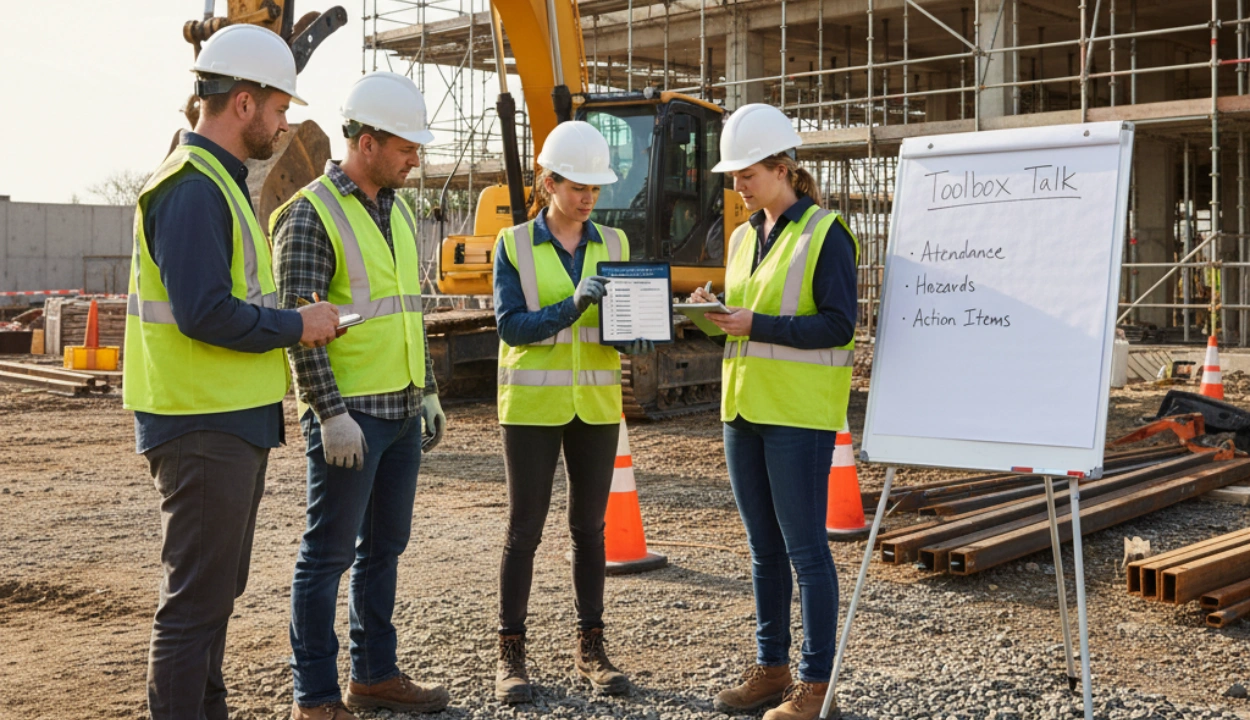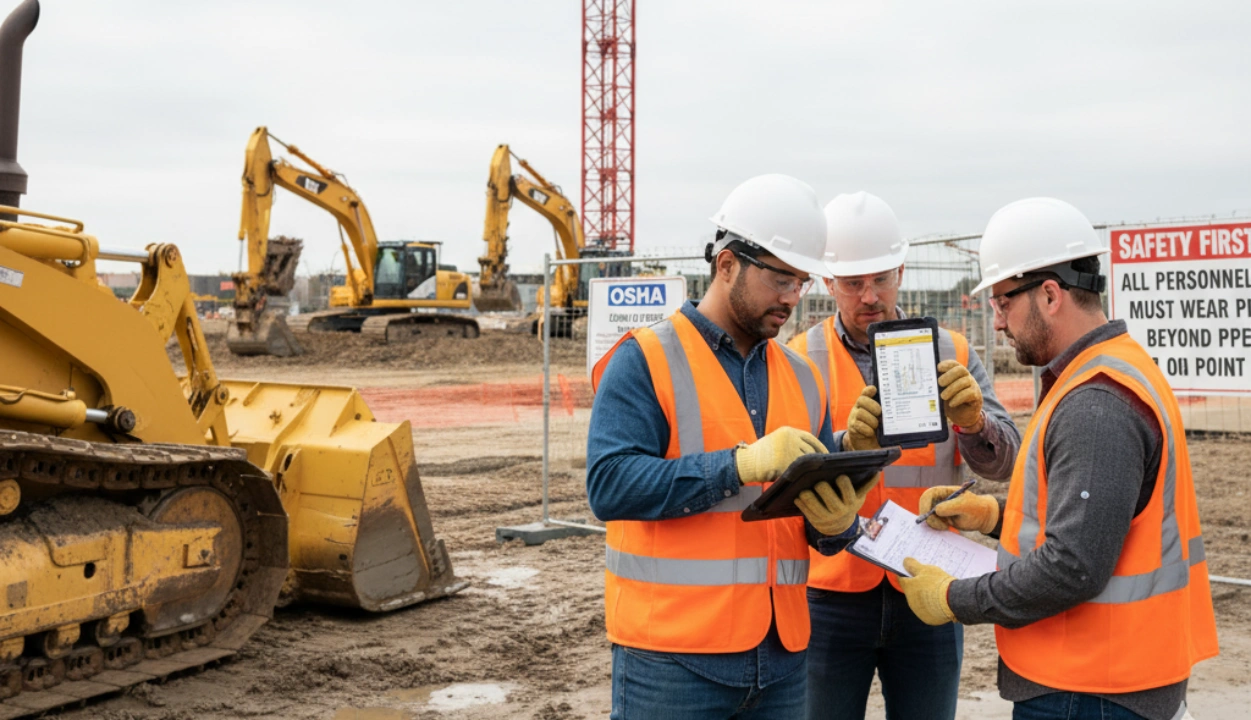How to Ensure Construction Worker Safety?
Ensuring construction worker safety is essential, especially in an industry that involves significant machinery and dangerous locations for workers.
Construction projects are considered dangerous fields. Therefore, strict safety measures must be enforced to avoid injuries and accidents.
To address frequent safety risks including falls and electrocutions, on-site site operators need to use proactive safety measures.
In this blog, we investigate measures to keep employees in construction safe during work.
Common Jobsite Safety Risks
The construction industry contains many dangers and threats which result in severe mishaps.
Despite the effectiveness of the safety protocols, it is worth pointing out that understanding these risks can greatly improve construction worker safety.
Starting with the most frequent hazards at the job sites known as The Fatal Four.
The “Fatal Four” are the most common reasons that result in construction site accidents and fatalities, which are stated by OSHA.
These include:
- Falls: Tripping and slipping remains a common cause of injuries in construction, contributing to 33.5% of construction deaths and injuries. Some hazards to workers include Working at heights, in areas with open edges, and on unstable floors, which present big dangers.
- Electrocution: This represents 8·5%. Poorly installed wiring, exposed electrical components, and a dangerous source of electricity can cause electrocution, therefore exposing the workers to great danger.
- Struck-by Incidents are responsible for 11.1 % of construction fatalities; non-workers interact daily with enormous tools, vehicles, and flying objects that are likely to result in struck-by mishaps.
- Caught in/between Accidents: This hazard leads to 5.5% of fatalities in every financial year. Workers can be stuck between machinery, equipment, or even construction materials, resulting in death.
OSHA, which sets construction worker safety standards, frequently records construction industry violations. OSHA 2022 list of top violations included:
- Fall Protection (Standard 1926.501): Leading the chart, improper or missing fall protection is one of the most cited OSHA violations.
- Hazard Communication (Standard 1910.1200): This ensures that information about the dangers of chemicals used on the site is communicated to all workers.
- Scaffolding (Standard 1926.451): Poorly constructed or unguarded scaffolds are a significant safety risk.
- Lockout/Tagout (Standard 1910.147): This relates to the failure to disable machinery to prevent accidental startups safely.
Effective Ways to Ensure Construction Worker Safety
To lower construction dangers and uphold safety for on-site workers, project managers need to deploy several safety protocols.
Let’s look at some of the most effective ways to enhance construction worker safety:
1. Create a Site Safety Plan

One of the most effective ways to ensure construction work safety is to create a detailed site safety plan.
This safety management document needs to identify risks and rules for handling emergencies.
It also needs to comply with safety standards for construction work and OSHA guidelines.
Every worker must understand and stick to the plan's objectives to ensure safety on-site.
2. Use Construction PPE’s

Personal Protective Equipment (PPE) like safety glasses for construction work, helmets, gloves, and high-visibility clothing are critical for worker safety.
These PPEs are designed in a way that they protect the workers while they operate and work around heavy equipment.
Hand, head, ear, and eye protection help protect the major senses of the workers and ensure that no damage is done to the worker's senses.
While safety harnesses and chaps protections help protect the workers from major fall risks.
Some PPE’s the construction workers can use include:
- construction worker safety harnesses
- construction worker safety gear
- Head protection
- Eye protection
- Ear protection
- High-visibility clothing
- Hand protection
- Steel toed boots
3. Safety Training for Workers
Training is a cornerstone of effective construction work health and safety.
Equipment managers must understand how to identify threats and employ devices safely at the time of emergency.
Safety training programs help build a safety culture in construction, reinforcing the importance of adhering to safety protocols.
OSHA provides training resources for project managers which they can access for free and use to ensure that all workers are properly caught up on all safety rules and regulations.
4. Use Visual Aids to Promote Safety

Posters and instruction videos support the construction worker's safety effectively.
These aids can serve as constant reminders to follow safety rules and wear construction worker safety glasses, helmets, and other protective equipment.
5. Clear The Streams of Communication
Clear and open communication is key to effective safety management for construction works.
Workers must be open to alert dangers or unsafe behaviors without worrying about punishment and repercussions.
Clear communication makes certain that safety guidelines are complied with and that problems receive immediate attention.
6. Keep The Site Clean

A clean construction site reduces the risk of slips, trips, and falls, which are common causes of injuries. A clean site is a safer site.
Make regular safety inspections a part of your preventive maintenance schedules to ensure that workers and equipment are protected from dangerous situations.
To ensure construction work zone safety you must have:
- Proper waste management
- Removal of debris
- Tidy workspace
- Dispose of hazardous materials
- Recycle and repurpose
7. Store Equipment in Its Place
Injuries can result from poor storage practices with equipment.
Completely arrange equipment correctly and at its proper location, you can use construction equipment management software for tracking assets and equipment and ensure they are in the right location.
This minimizes clutter and ensures that essential construction worker safety equipment is always easily accessible.
8. Inspect Equipment Regularly

Checking tools and machinery often plays a key role in avoiding issues that might cause accidents.
Maintenance and repair are not just costly but improper maintenance activities can lead to dangerous situations for construction site operators and workers.
Faulty equipment is a serious threat to construction night work safety and daily operations alike.
Creating a fixed inspection schedule assures that all equipment functions safely.
9. Create a Construction Site Safety Checklist
A detailed safety checklist guarantees that safety practices are executed regularly.
The checklist should cover:
- PPE usage
- Machine inspection
- Fire safety in construction work
- Other critical areas
Checklists are a simple but effective way to ensure nothing is overlooked in construction worker safety.
For more clarity you can check out a visual example of a safety checklist below.
10. Immediately Report Issues
Encourage workers to bring to attention any violations or threats they find immediately.
Urgent reporting enables you to resolve difficulties before they become serious safety challenges.
Workers should know that reporting unsafe conditions is fundamental to construction worker safety rules.
Some issues that can happen at a construction site include:
- Tripping hazards
- Collapse
- Electrocution
- Air contaminants
- Asbestos
- Chemical exposures
- Machinery malfunctions
Using the detailed reporting and analytics feature on construction equipment management software, you can get information on issues that can arise while operating.
The software also sends automated notifications if any issues arise on site, allowing you to actively manage the issues on site.
11. Prepare an Emergency Response Plan

Even with proper preventive maintenance plans and safety protocols, issues can arise unexpectedly.
This is why you must be prepared with a proper emergency response plan to ensure that even if unexpected issues arise, you are prepared for them.
You can create a stellar emergency response plan by following these steps:
- Hazard identification and assessments - Identify areas where risks can arise.
- Emergency resources - Identify your emergency resources and ensure that contingency plans are in place.
- Communication planning - Ensure that reliable communication equipment is being used to make sure that you are ready to respond on time.
- Emergency response procedures – The following list covers basic actions to take in an emergency. These steps apply to almost any emergency and should be followed in sequence. Stay calm, assess the situation, take command, provide protection, aid and manage, maintain contacts, and guide emergency services.
- Debriefing and post-traumatic stress procedures - Once the emergency is over, ensure that all in the vicinity have the proper help they require to recover.
12. Work with Your Insurance Provider

Your insurance provider can offer valuable insights into construction worker safety.
You could receive their assistance regarding programs and services to lower risks and boost safety.
By partnering closely with your insurer, you can minimize accidents and reduce the cost of your insurance.
To make things easier here are a few factors you should look for in an insurance plan:
- Workers compensation
- Liability insurance
- Construction bonds
- Commercial auto insurance
- Worker and third party safety
- Pollution liabilities
To Sum It Up
To ensure construction worker safety, it is important to stay informed about the latest developments in construction work safety management.
You can continuously improve your safety practices by keeping abreast of changes in regulations, innovations in construction worker safety equipment, and advancements in construction work health and safety.
You can utilize resources provided by OSHA and on our blogs to get more information on safety procedures and protocols.
FAQs
Why is construction a high-risk industry?
The risks of construction are elevated because of the presence of tall ladders, heavy machinery and electricity hazards. The possibility of incidents compels us to adopt critical safety standards.
What is safety culture in construction?
The workplace safety culture includes common beliefs and behaviors concerning safety. In a nurturing safety atmosphere valuing worker safety rules encourages employees to practice safety.
What is the number 1 OSHA violation?
In construction industry operations; fall protection (Standard 1926.501) ranks the most serious OSHA violation. Employing fall protection is key to reducing the number one leading cause of fatalities at work.
What are the 20 20 20 rules in construction safety?
This guideline helps decrease eye strain during work. Workers must take breaks each 20 minutes and observe an object 20 feet away for 20 seconds while donning safety eyewear to avoid harm.
Transform Your Equipment Management












